Inhuman Guardians of the Sky
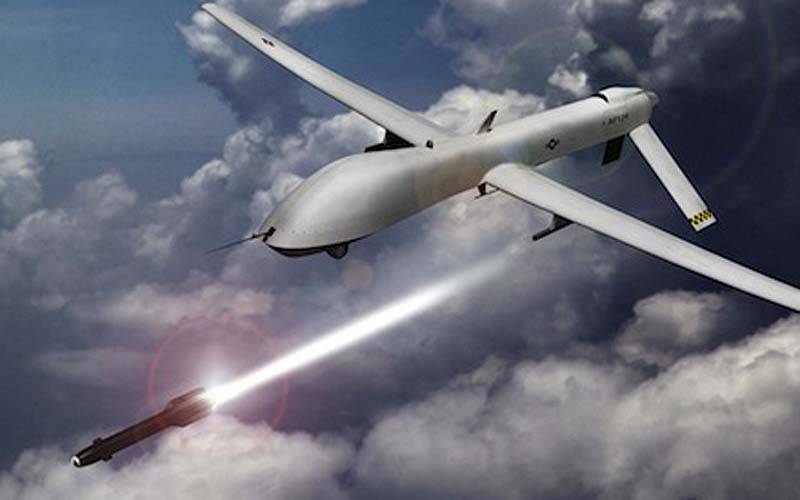
It is important to distinguish attack unmanned aerial vehicles from more familiar drones, originally created for reconnaissance and information gathering, and subsequently equipped with various weapons. This is combat aviationwhich must carry out dangerous combat missions without fear and reproach without a pilot on board. As such, it represents a very popular combination of combat aircraft and UAV technology. Its creation required the tremendous efforts of leading Western armies and their industrial partners, which gave rise to a number of technological demonstration programs that are beginning to transform into development projects aimed at increasing operational capabilities.
While the US fleet is in the process of redefining its UCLASS system (Unmaned Carrier Launched Airborne Surveillance and Strike) for less aggressive tasks, for example, in carrier tanker aircraft, the TARANIS and nEURON demonstration systems appear to be the ancestors of unmanned aerial drums first generation vehicles (UBLA) in the UK and Europe as part of the FCA3 program (Future Combat Air System - a promising combat aircraft).
Dassault nEUROn at the air show in France in 2013
Currently, four large US companies selected as part of the UCLASS program take part in the work on the deck drone: Northrop Grumman with the X-47B UAV based device, Boeing with the Phantom Ray UAV based device, Lockheed Martin with its Sea Ghost and General Atomics with Sea Avenger.
It is worth seeing here what the various technology demonstration programs have achieved, but no doubt Northrop Grumman’s X-47B recognition has reached its maximum level. This device has recently demonstrated amazing technological maturity, taking off from aircraft carriers among manned platforms and refueling independently in the air as part of the program fleet UCAS-D, which followed the closure of the J-UCAS program in 2006.
As a refinement of the X-47A PEGASUS project, which Northrop Grumman manufactured according to the J-UCAS program and which took off for the first time in 2003, X-47В had to demonstrate that it complies with all the standards and regulations of service on the aircraft carrier. This, above all, is about compliance with the requirements of the Command of Naval Aviation Systems, improving reliability, resistance to damage, organizing logistics within the aircraft carrier and flight control systems, necessary operational parameters and flight performance. In addition, he needs a catapult attachment, a tail hook and a more durable chassis.
In order to work safely in the conditions of the powerful electromagnetic fields of the deck of an aircraft carrier, the drone had to pass tests for electromagnetic compatibility. The first launch from a ground-based ejection installation was performed at the Patuxent River Flight Test Center in November 2012, the first landing with immediate take-off after touching using relative GPS navigation was made by the device in March 2013, and the first landing on the aircraft carrier deck using an aerofinisher two months later.
Although the US Navy wanted to decommission experimental samples, it was decided to continue flying further. In the 2013-2015 years, three more tests were conducted on the aircraft carrier, mainly to demonstrate the ability of the UBLA to work seamlessly with the aircraft wing of the aircraft, which includes the order of 70 of various aircraft. The objectives of these stages were achieved, 16 precision approaches were completed, five missed approaches, nine landings with immediate take-off after touch, two landings with an airfinder and three takeoffs with the help of a catapult.
During the tests, a large number of takeoffs and landings were performed on the decks of two ships at sea. All targets were achieved, including successful first night operations on the deck and first night flights, launches and returns at 90-second intervals mixed with HORNET fighters. In April, 2015, the X-47B drone, performed the first independent air refueling using the standard taper-rod system paired with the KS-707 tanker aircraft from the Omega Air Refuelling fleet (a private company providing air refueling services to the US military) . The key technology in this process is the interaction system during refueling RIS (Refueling Interface System) on board the tanker aircraft, with which UBLA exchanged messages during a test flight. The drone independently maneuvered in order to combine the fuel rod and the cone. Successful refueling actually marked the completion of the development of a new apparatus.
The modified Boeing 707 from Omega Air acts as a drone driver Northrop Grumman X-47B, April 2015
Ghosts, Ghosts and Phantoms
While some credible facts are available about Lockheed Martin's Sea GHOST drone (Sea Ghost), based on the RQ-170 SENTINEL model, the company revealed its priorities in the UCLASS program, most of which undoubtedly concern the RAQ-25 reconnaissance-strike tanker STINGRAY. They include the provision of affordable, reliable and continuous intelligence, observation and information gathering, as well as “full adaptability” in order to carry out operations in any scenarios and in any combat situation. The company also focuses on controlling the unmasking features, implying multispectral stealth, controlling engine emissions and radio emission.
Lockheed Martin also stresses its intention to integrate technologies tested on manned and unmanned systems, including the “maximum reuse” of the hardware and software parts of devices such as the F-35C, RQ-170 SENTINEL and others. According to the company, the concept of a drone, based on an open architecture, aims to reduce the time and cost of system integration, because you can reuse proven hardware and software and systems without unnecessary expense.
Control of several devices by one operator is considered very important for working with UBLA. As part of the UCLASS project in July 2013, the capabilities of the Navy aviation systems command were demonstrated. The control system of the UAVs and their sensors developed by Lockheed Martin, integrated with other planning systems, operational management and intelligence gathering information of the American fleet, was able to provide operators with an exhaustive picture of the combat mission.
How close is the project Boeing UCLASS and possibly currently competing UAV RAQ-25 CBARS (Carrier Based Aerial Refueling System) to the PHANTOM RAY platform, has not been publicly discussed. However, since the beginning of this century, the company has achieved a lot and gained tremendous experience with UCAV technology, mainly with the X-45 options on the J-UCAS program and in the UCAS-D program competition, which it lost to Northrop Grumman. Boeing used software developed for offshore UCAV variants, installing it aboard an F / A-18D HORNET fighter to demonstrate automatic landing on an aircraft carrier.
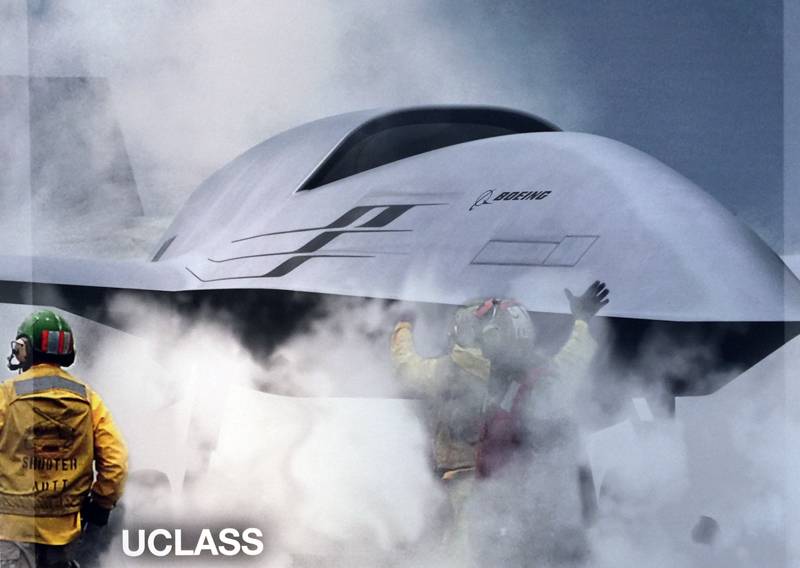
Artistic presentation of the UCLASS platform, included in the Boeing exhibition at Sea Air Space 2015
During its first 22 flight in May 2002, for example, the first of two X-45A drones showed good flight characteristics and basic elements of air operations, in particular, the control channel between the aircraft and the ground station. In April, 2004, the demo model X-45A, hit the ground target with a high-precision, inert bomb 113 kg, dropped from the internal compartment. In August 2002, the first autonomous flight of several UAVs was performed under the control of the operator. Flight tests were successfully completed in the 2005 year and the next year the two vehicles went to museums.
In April 2003, the Advanced Defense Research Authority DARPA announced that it wanted to have a larger version that could meet the requirements of the US Air Force and Navy for the J-UCAS project; it became the platform X-45С. In May 2009 of the year, three years after the cancellation of the J-UCAS project, Boeing announced that, on an initiative basis, on the basis of the X-45C prototype, PHANTOM RAY will be developed as a flying testing laboratory of advanced technologies.
The Textron RQ-7 SHADOW armed reconnaissance drone, the workhorse of the American army, allows advanced forces not only to observe and reconnoiter, but also to quickly destroy targets that appear for a short time before they can disappear, for example, mortar groups, terrorists, laying IEDs, or packed full of unknown than pickup. It is also almost perfect for busy urban areas, where it is often impossible to drop a large bomb, such as a JDAM, or use other fire support, such as artillery.
The SHADOW complex consists of four UAVs with a target load, a launcher and ground control and support equipment, including a power supply source, communication equipment, automatic return means, video terminals, a carport and a HMMWV vehicle with a trailer. Each complex is equipped with one MSM maintenance section (Maintenance Section Multifunctional) and is serviced at the level of a mobile workshop brigade. The basic target equipment is an optoelectronic / infrared station with a laser target designator.
The larger RQ-5 HUNTER drones were tested with VIPER STRIKE mini-bombs, and the MQ-1G SKY WARRIOR unmanned aerial vehicles could carry up to four HELLFIRE missiles, but in the American army these drones are much smaller, which is not the case for RQ-7 SHADOWS of smaller size . The typical combat load of a SHADOW BLAH is just two missiles, one under each wing. Available weapons include a small-caliber GRIFFIN mini-rocket developed by Raytheon or VIPER STRIKE from Northrop Grumman. LAHAT Israeli missile, developed by Israel Aerospace Industries (IAI), can also be mounted on this drone. In the combat load of the drone may include non-motive means of destruction, for example, guided mortar shells.
The GRIFFIN mini-rocket is ideal for situations where size and weight are critical factors.
The Turkish joint venture Kale-Baykar, created by the Kale Group and Baykar Technologies, developed the BAYRAKTAR tactical UAV, a reconnaissance and surveillance system originally intended for the Turkish armed forces. 5 August 2014, he set a record for the duration of an independent flight, when 24 flew an hour 34 minutes at an altitude of 5500 meters. In addition, the BAYRAKTAR TB2 drone successfully demonstrated the launches of Roketsan MAM-L smart ammunition in December 2015.
SEA AVENGER
UAV Sea AVENGER company General Atomics Aeronautical Systems (GA-ASI) differs from the others in that it is a further development of the proven family of remotely piloted aircraft PREDATOR. These UAVs, originally created as platforms for continuous observation and information gathering for flying in enemy-free airspace, flew millions of flying hours, demonstrating their impact capabilities in real combat operations.
Sea AVENGER is nothing more than a variant of the PREDATOR C drone with a Pratt & Whitney PW545B engine, capable of operating from aircraft carriers. Its weight is 8255 kg, a wingspan of 20,1 meters and a fuselage length of 13,4 meters. Although it has thickened, deeply recessed wing roots with a certain fairing with the fuselage and an internal armament compartment, a large relative elongation of swept wings, a bulbous front fuselage due to a satellite communication antenna, plus a V-shaped tail unit, it speaks of its connection with the PREDATOR drone. and hint that low visibility was not at the forefront of the design. However, the company says that "its unique design, reduced signatures and speed" increase survivability in conditions with higher threat levels and provide enhanced capabilities for reconnaissance and rapid armed response.
UAV PREDATOR-C AVENGER with its weapons
The first flight of the PREDATOR C in April 2009 of the year was followed by a second flight in January of 2012; In addition, the construction of the third and fourth vehicles. GA-ASI, in May 2010, proposed a maritime option for the UCLASS competition, winning one of four research contracts in August, 2011.
In November 2012, the SAE AVENGER drone (PREDATOR C) flew for the first time under the control of an operator from the Advanced Ground Control Station (ACGCS). The ACGCS station features a panoramic display and a multidimensional moving map designed to increase the level of control of the situation, as well as an integrated on-board digital instruction to reduce the burden on the operator. As emphasized in the company, intuitive interfaces with better ergonomics are designed to simplify the identification of hazardous situations, they increase safety and reduce pilot response time and decision-making process. The system, which takes into account the wishes of the Ministry of Defense to improve the level of unification, is designed to work with the entire line of GA-ASI drones.
The company emphasizes that the uniformity of materials and avionics with PREDATOR B contributes to a further reduction in the cost of AVENGER, while the advanced capabilities allow it to be used in massive swarm attacks. This aircraft is currently undergoing extended flight tests.
An option with an increased range should be completed this year; it will have a wingspan of an 23 meter and an increased fuel reserve in order to increase the flight time to 20 hours.
In February, the 2013 of the year, the UCLASS project was transformed into an unmanned tanker aircraft RAQ-25 Carrier CBARS (Based Aerial Refueling System), which the American fleet wants to call STINGRAY. He will also have intelligence and "limited strike capabilities", although, according to some reports, these strike capabilities may be delayed until the next option. Creating an unobtrusive unmanned tanker makes some sense, since the F-35 fighter cannot operate far from US bases without the support of tankers, and existing tanker aircraft are unlikely to survive in a difficult combat situation with a high level of threats in which Russian C-7 300 and C-400 or their analogues or other modern means of blocking the zone. In addition, the combat stability of the UBLA swarm can be significantly improved if you take along the same type of subtle tanker.
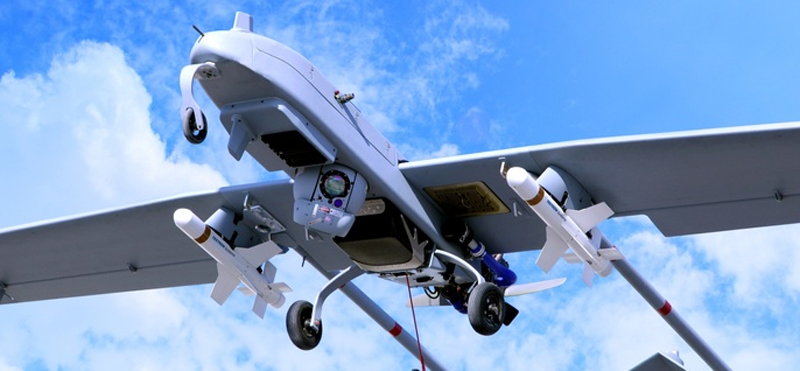
The tactical UAV SHADOW 200 was selected by the US Air Force and Navy for reconnaissance, surveillance, target designation and evaluation. It was reported that in January 2016, the US Army issued a contract to Textron Systems for 97 million dollars to modify the tactical drones RQ-7B SHADOW. At the moment, several Arab countries are interested in acquiring armed options SHADOW
NEURON and TARANIS show their abilities
In addition to the United States, Europe also does not forget about drums drones. It hosts the French-led nEURON Technology Demonstration Programme, which also includes Italy, Greece, Spain, Sweden and Switzerland. The project was launched in 2003, the main partnership agreement was signed in 2006, and the only device made its first flight in France in December 2012.
In November 2015, the Swedish Defense Purchasing Authority reported that the nEURON experimental reconnaissance and drone drone had passed a series of flight tests at the Vidsel test site, which aimed to determine what the subtle ULVA looked like for ground and air systems, including the GRIPEN fighter, and according to the project's curator, GRIPEN, in the Department, “to see if nEURON is as good as the French say about it”.
Handsome nEURON - the fruit of European efforts
The two series of test flights, 11 and then 8, conducted by the Swedes, allowed the GRIPEN C / D and GRIPEN E fighters, the newest ASC 890 variant of the Saab ERIEYE long-range (radar) detection and control aircraft, and the UndE airborne reconnaissance radar (GIRAFFE) to determine the distance, with which you can find a drone nEURON. Measurements were made and other ground-based radar and infrared systems. UBLA also made three bombings, firing three test inert weapons. All the results of these tests were classified.
And before that, a series of tests was conducted at the Decimomannu test site in Sardinia, about the completion of which Finmeccanica reported to 2015 in August. These tests in real conditions included 12 "top secret" sorties focused on testing combat capabilities. Tests confirmed the effective reflection area (EPO) and infrared signs of UAV visibility. Flight missions included flights at various altitudes, interaction with various threats, both ground and air, including Eurofighter TYPHOON. As was the case with tests in Sweden, little information was published, but Finmeccanica said that the tests confirmed the “excellent” performance and high operational reliability of the nEURON UAV.
In turn, these tests were based on a series of tests that were conducted at the test site on the French island of Istres, which ended in February 2015, the hundredth flight of this device. At the first stage, these tests focused on expanding the range of flight modes, including flying with open bomb compartments, the operation of optoelectronic equipment and the evaluation of communication channel parameters. At the second stage, its infrared and electromagnetic signatures were evaluated when working on air defense facilities.
The British independent project TARANIS was officially introduced in July 2010, after 2005 was entered into the UK defense strategy in December. A demonstration sample the size of a HAWK training aircraft weighing 8000 kg first flew at the Woomera test site in Australia in 2013 after passing preliminary tests for demasking signs in England in 2012 in England where its EPO and IR signatures were tested.
UBLA Taranis at the airbase in England, in the background Typhoon fighter, 2015 year
The successful completion of the second stage of flight tests was announced in July 2014. The drone was completely in stealth configuration, all antennas were replaced with signature control options, and the nose rod of the aerial signal receiver was removed. The LPD / LPI communication system was also used (with a low detection probability / low interception probability).
TARANIS completed its third and final series of tests in November 2015, the purpose of which was to confirm its small EPO. According to the company BAE Systems, the platform met all the objectives of the tests and the expected flight conditions.
The main technologies developed within the project include a remote control system for a platform with a high degree of instability and embedded sensors necessary to replace the very visible sensors of the air situation system and air pressure receivers. The company also mentioned the successful integration of on-board equipment for the engine, engine and communications equipment into an inconspicuous platform, and, as far as technical issues are being resolved, the systems are critical for safety.
NEURON plus TARANIS equal to FCAS?
The nEURON and TARANIS programs reached their final stages at the same time and the United Kingdom and France announced their intention to allocate million pounds for 750 to develop prototypes of ready-to-use UBLA as part of the Future Combat Air System project. In the summer of 2014, 120 of millions of pounds was allocated for a feasibility study, and full-scale development was to begin in 2017. Given the delays and cancellations of the programs, plus the redefinition of the combat assignment of new platforms, which American industry had to face, Europe can deploy a ready-made modern specialized ULAA at the same time or even before the United States.
HERON
According to reports, the Israeli UAI's IAI reconnaissance drone is capable of staying in the air for more than 24 hours, flying at altitudes of the order of 10000 meters. IAI claims a flight duration of more than 40 hours and a record of continuous flight for 52 hours. The maximum range of the UAV is about 3000 meters, it can carry a maximum target load of 250 kg. Such a large drone class MALE (medium altitude and long duration of flight) can take very different target load, designed to perform a variety of tasks. This could be an optical-electronic station specific intelligence, synthetic aperture radar for ground surveillance, marine search radars and sensors, antennas and equipment for electronic reconnaissance and information gathering, laser designators, and even radio repeaters. HERON can designate targets for fighter jets, helicopters and missiles. HERON drones can also be equipped with air-to-surface missiles, which determine, escort and destroy targets in the depths of enemy territory.
UAV HERON -1 drone
India is already operating a fleet of unarmed HERON and SEARCHER UAVs, using them to monitor and collect information. The adoption of the armed army of UAVs will become a serious expansion of its capabilities and will allow to clear out large terrorist camps or individual objects in enemy territory with minimal risk. In 2015, the Indian government approved the purchase of ten armed UAVs from IAI worth 400 million dollars as part of the accelerated Modi administration program. The ten HERON TP drones have joined other Israeli platforms in service with the Indian Air Force, locking in on HARPY ammunition, SEARCHER reconnaissance vehicles and the unarmed HERON-1 UAV. The country also implements its own UAV development program under the designation RUSTOM 2.
HERON's leased drones of different variants worked in Afghanistan in the Australian, Canadian, French and German contingents. They are also in service with the US Armed Forces Command in the zone of Central and South America. There is confirmed and unconfirmed information on sales of UAVs HERON Brazil, Ecuador, Singapore and Turkey.
GRIFFIN small guided munitions are already available for upgrading manned rotary-winged platforms; it is quite possible that soon it will also be integrated into vertical take-off and landing drones
Expansion of the contingent of users: locking options
Another unmanned kinetic concept is becoming increasingly popular. These are the so-called barracking ammunition, which allows the armed forces to respond quickly to targets that are subject to immediate destruction. In effect, the patrol ammunition allows reconnaissance weapons to destroy targets in a timely manner and with high accuracy. One such ammunition is the SWITCHBLADE impact drone from AeroVironment, which, according to the company, is a highly accurate guidance solution with off-line guidance, causing minimal indirect damage. This system was evaluated by the US Marine Corps. A company representative noted that “this miniature, remote-controlled or autonomous platform can either plan or fly on a silent electric motor, providing real-time GPS and video coordinates for the purpose of collecting information, targeting or recognizing objects / terrain. The small size of the device and the silent engine make it difficult to detect, recognize and track even at a very short distance. SWITCHBLADE is fully scalable and can be launched from various air and ground platforms. ”
SWITCHBLADE is the first development under the program of the Air Force and the Special Operations Forces Command for the LMAMS (Lethal Miniature Aerial Munition System) miniature airborne lethal ammunition. The device has a maximum range of up to 15 km and flight duration up to 20 minutes. It is equipped with CCD / IR cameras, a thermal imager and 300 grams with a non-contact laser fuse, pointing forward and to the sides. Other applicants for the LMAMS program were T-RAM from Textron Systems and SkyStinger from IATech. However, LMAMS is still awaiting the status of a priority program, but industry experts say that this will happen no earlier than 2019 of the year.
Israel Aerospace Industries (IAI) has created advanced versions of its anti-warhead ammunition HARPY, currently in service with many countries, including Israel and India. At the Singapore Airshow 2016 Singapore Air Show, IAI showed the newest members of their family of ammunition patrols: HARPY NG, designed to counter modern radar air defense systems, which have seriously advanced in development since the adoption of the previous version of this munition; GREEN DRAGON, tactical low-cost ammunition designed to arm small units and special forces in order to increase the level of possession of the situation and lethal effects; and the ROTEM L quadcopter, which can carry a one-kilogram warhead, consisting of two grenades, which detonate when the drone contacts the target. The warhead can be replaced by surveillance equipment (infantryman can carry up to three systems, the range of stable communication with the device is 5 km and flight duration up to 30 minutes). The barrage ammunition, as a rule, is made according to an aircraft scheme, has a high speed, so the rotary-wing configuration in this case is an innovative solution.
IAI systems can be equipped with a MicroPOP sensor head and a high-explosive fragmentation warhead with a mass of 4 kg. The next generation barrage munitions are developing rapidly, undergoing advanced testing, and they can be launched from any land, air and sea carriers.
Finally, UVision is finalizing the development of its HERO 120 projectile munition, designed to destroy tangible property at close range. This option carries a warhead weighing 3,5 kg. The company says that its drone HERO 120 weighs a total of 12,5 kg, has a maximum flight duration of one hour and a range of over-the-horizon communications up to 60 km.
The Uvision HERO family of smart anti-burglary munitions, capable of delivering high-precision strikes in urban areas or at remote sites, currently has six options; of these, the smallest unit is the HERO 30, and the most high-tech unit is the HERO 900. However, a Uvision spokesman said that his company is currently working on a seventh, larger version of HERO 1250. With a calculated weight of 125 kg, the new version can carry a larger combat weapon of destruction compared to the HERO 900 model (photo below) with a total weight of 20 kg. He also said that the development of the HERO 1250 will be completed faster than IAI’s development of its new HAROP drone.
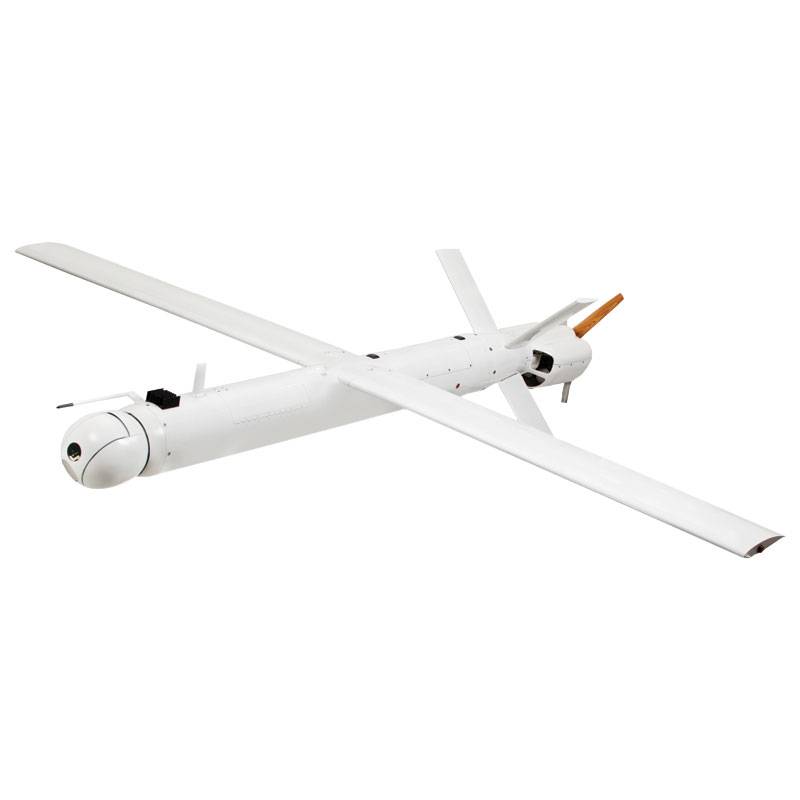
He stated that they would be able to offer the same opportunities as IAI with their HAROP, but at only a quarter of the cost. Uvision is confident that its HERO 120 will soon make its first flight with a weapon of destruction, which will make it the first vehicle available to potential customers in the line of new systems, which also includes the HERO 70, 250 and 900 models. Meanwhile, previous versions of Uvision HERO 30 and 400 have already been ordered by several buyers.
In recent years, the use of light small-sized UAVs on the battlefield has expanded significantly. These tactical UAVs can cause irreparable damage with their precision weapons:
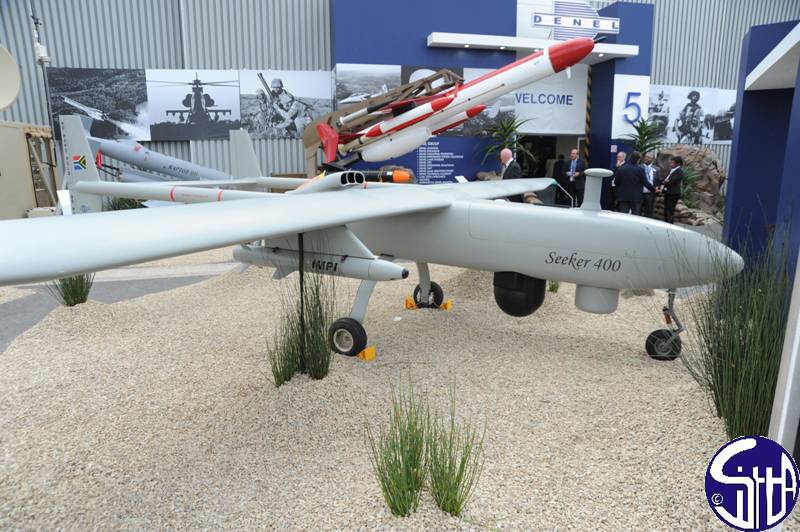
(1) The high-precision IMPI-S munition (pictured at the Cape Town exhibition) originates from the field-proven Denel Dynamics anti-tank missiles, IMGWE short-range and MOKOR
(2) Small Air Bomb Extended Range (SABER) ammunition developed by MBDA, featuring laser semi-active self-homing on the final trajectory
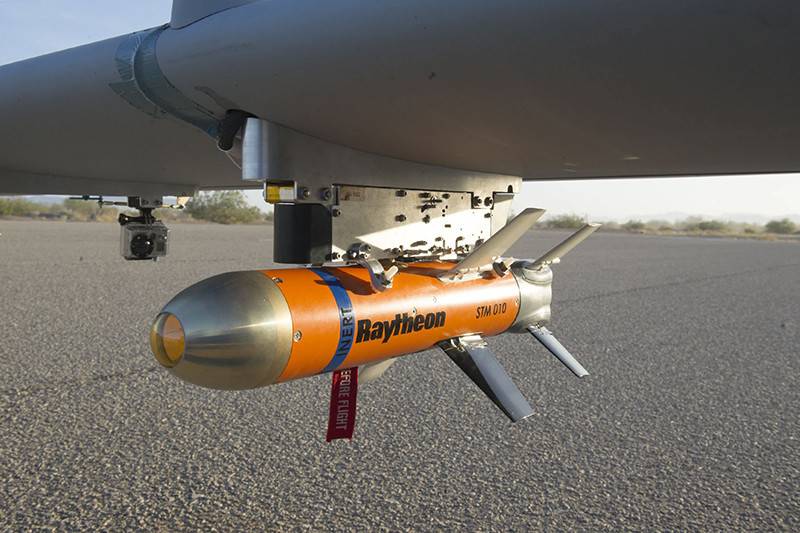
(3) PYROS Small Tactical Munition (STM) tactical guided munition weighs only 6 kg. Its universal warhead has a fuse that operates in three modes: undermining at height, shock and with a delay
(4) Orbital-ATK's innovative, adjustable HATCHET mini-bomb was developed with funding from the US Air Force research lab. The tiny ammunition, the size of which resembles an 20-mm artillery shell, weighs only 3 kg and at the same time maintains high accuracy due to its laser semi-active guidance. The media reported that even larger drones, such as the MQ-1 PREDATOR, can carry dozens of HATCHET mini-bombs in order to create a “cluster bomb” effect.
(5) Thales Free Fall Lightweight Modular Missile (FF-LMM) company Thales, in the United States, known as FURY; In the photo, mini-rockets are attached to the Harris BRU-S5 / A Smart Rack suspension assembly.
Envoy of the Olympian gods
The mid-range drone HERMES 450 (photo below) of the Israeli company Elbit Systems provides ground-based intelligence with real-time intelligence. The UAV (length 6,1 m, wingspan 10,5 m and weight 450 kg) is designed to perform long tactical tasks. HERMES 450 can carry various target loads (150 kg, 300 A, 1,6 kVA) and effectively carry out visual and radio reconnaissance, work as a radio repeater and perform other tasks at the level of the division and corps. The drone body is equipped with two suspension assemblies, optional suspension assemblies on the wings are possible. In Israel, it is used as a drone with shock and reconnaissance capabilities.
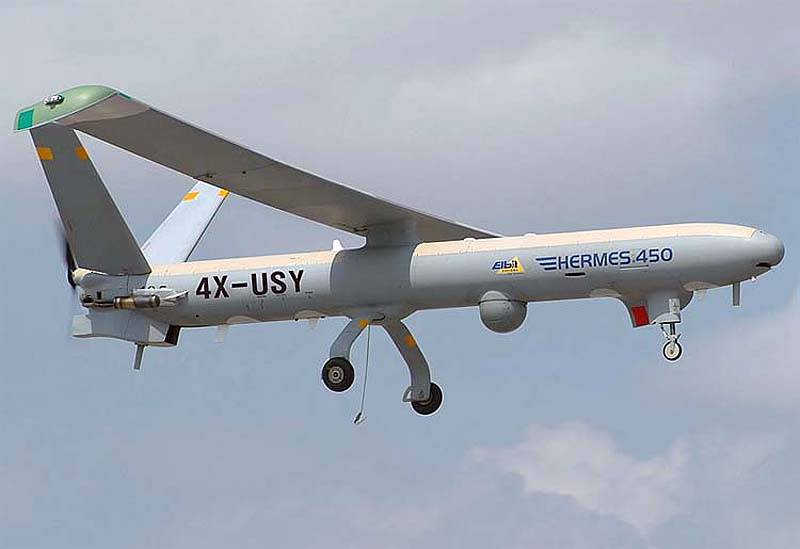
Unarmed vehicles are operated by a number of foreign customers, including Azerbaijan, Brazil, Georgia, Mexico, Singapore, the US Border Patrol, and in the UK it works as a reconnaissance vehicle under the designation WATCHKEEPER WK450B. According to the company, the HERMES 450 UAV can carry up to two Rafael SPIKE missiles.
FFLMM planning missiles under the wing of a Watchkeeper 450 drone
HERMES 900 is a larger platform with a wingspan of 15 meters and a maximum take-off weight of one ton. Compared to the 450 model, it can fly at high altitudes up to 9000 meters, the flight duration is 30-36 hours, and the target load is 350 kg, which is twice the capacity of the 450 model.
Israel announced recently that its UAV HERMES 900 received the local name Kochav (star), and the Israeli press indicates that HERMES 900 can carry HELLFIRE missiles, since the payload of the drone 350 kg allows it. It was reported that HERMES 900 with two internal suspension nodes in addition to the four underwing suspension nodes was sold to an unnamed NATO country, but this information is not confirmed by either the Israeli Ministry of Defense or Elbit Systems.
On the materials of the sites:
www.nationaldefensemagazine.org
www.boeing.com
www.northropgrumman.com
www.lockheedmartin.com
www.ga.com
www.textron.com
www.baesystems.com
www.iai.co.il
www.avinc.com
elbitsystems.com
www.theuav.com
the hi-news.r
en.wikipedia.org
pinterest.com
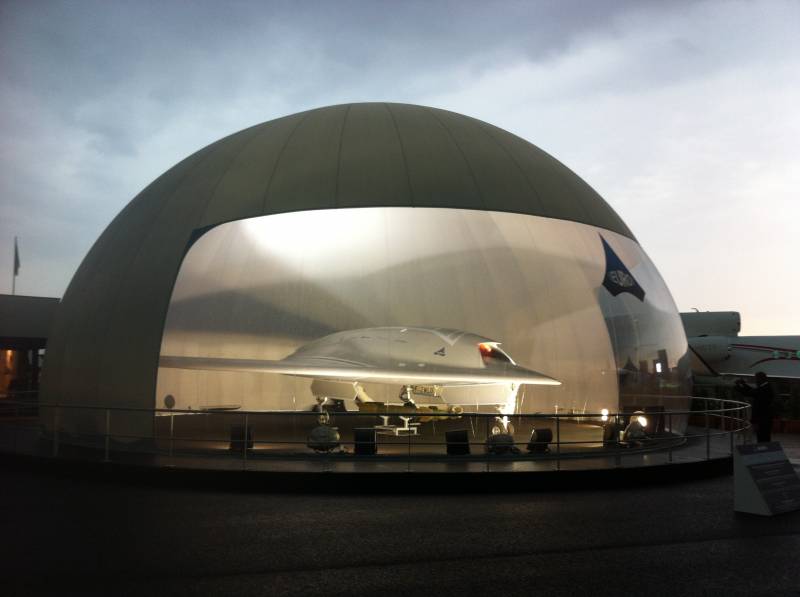
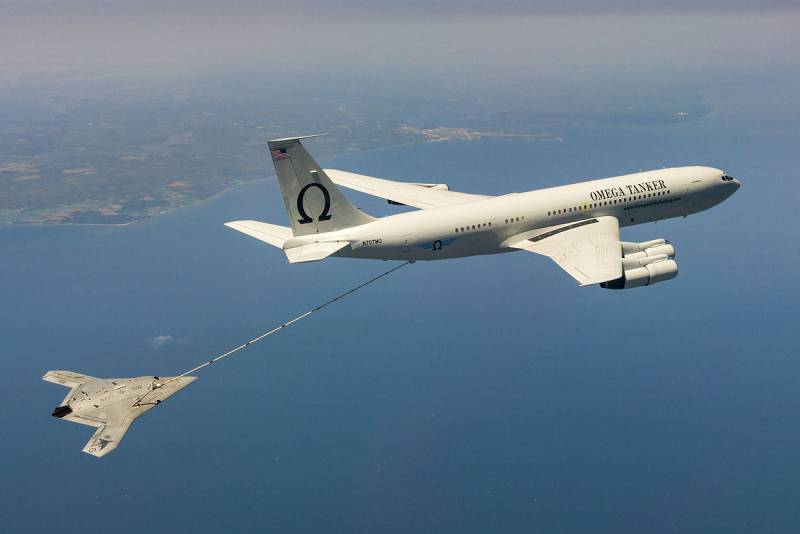
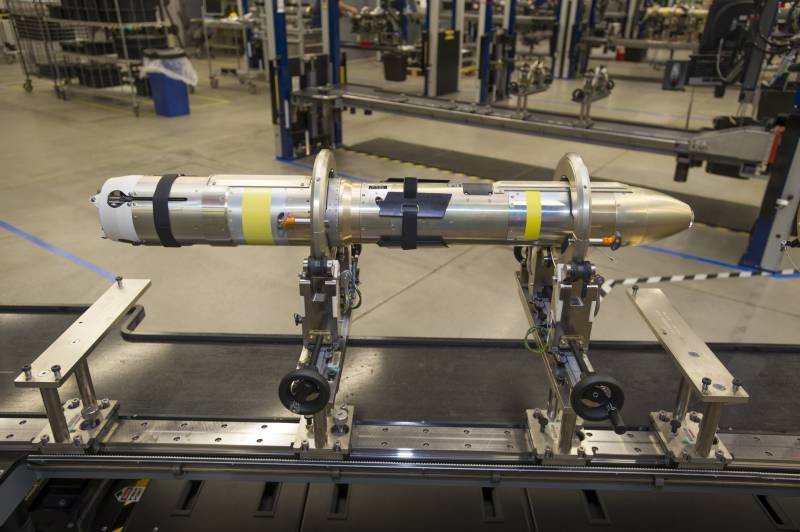
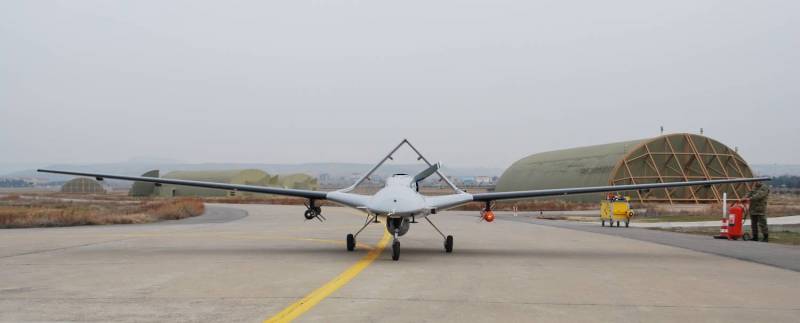
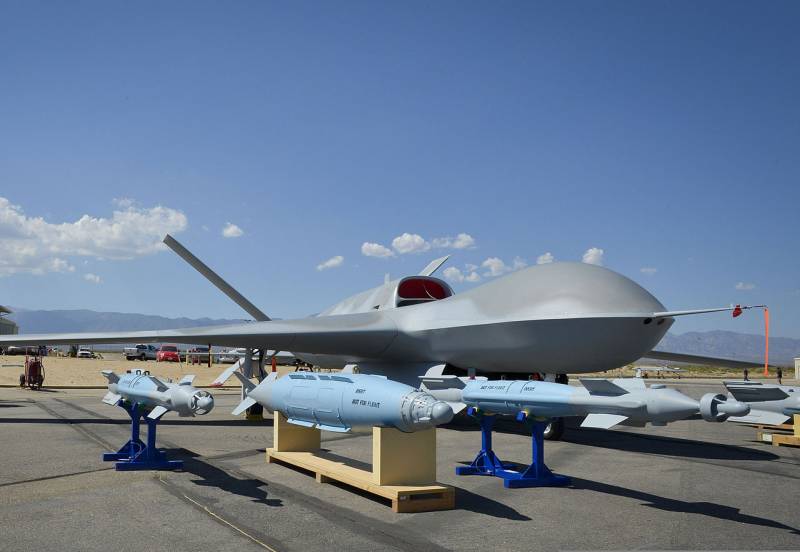

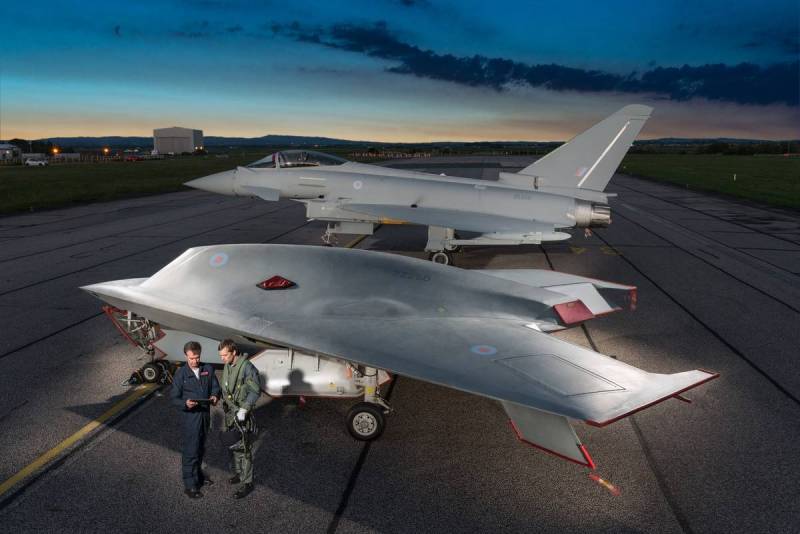
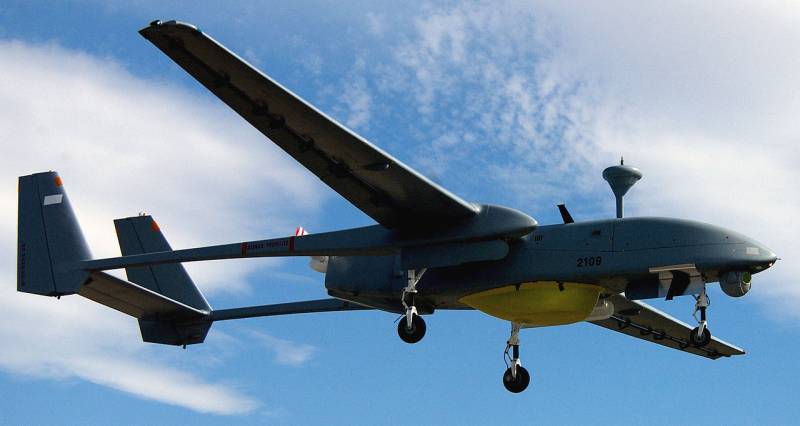
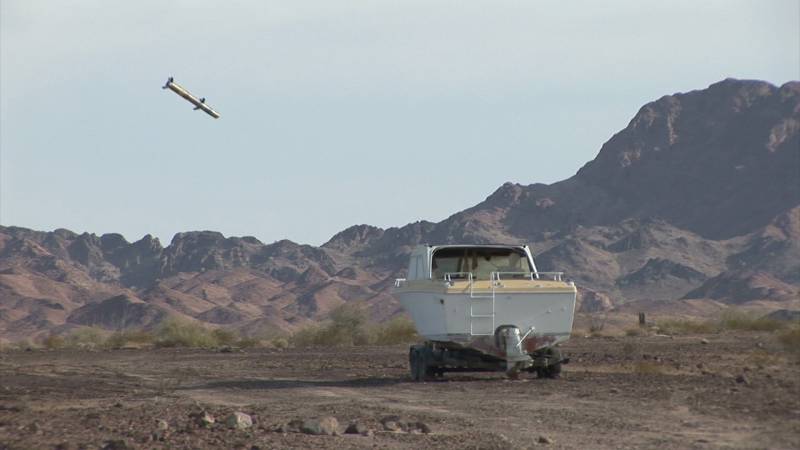
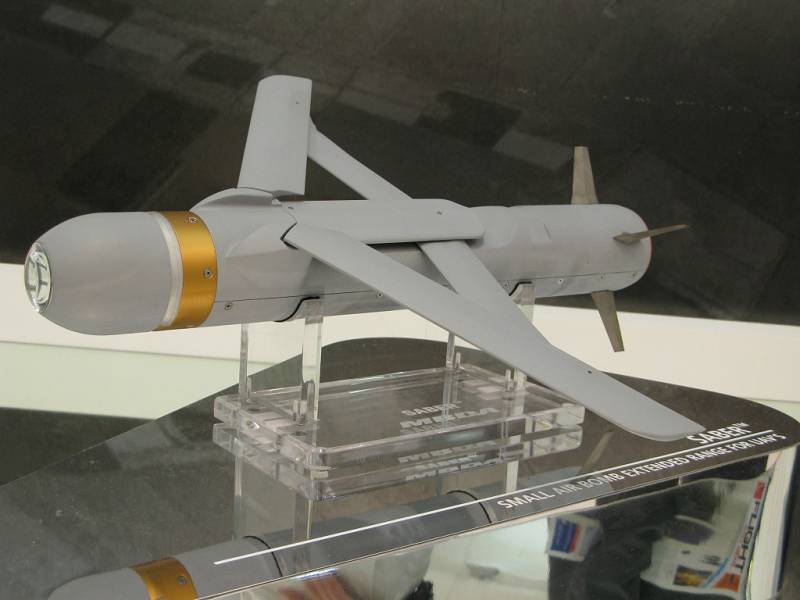
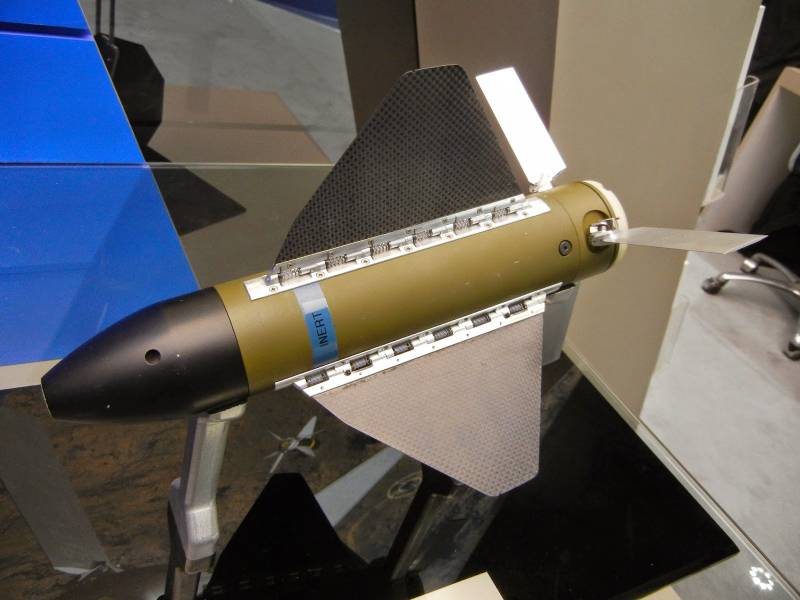
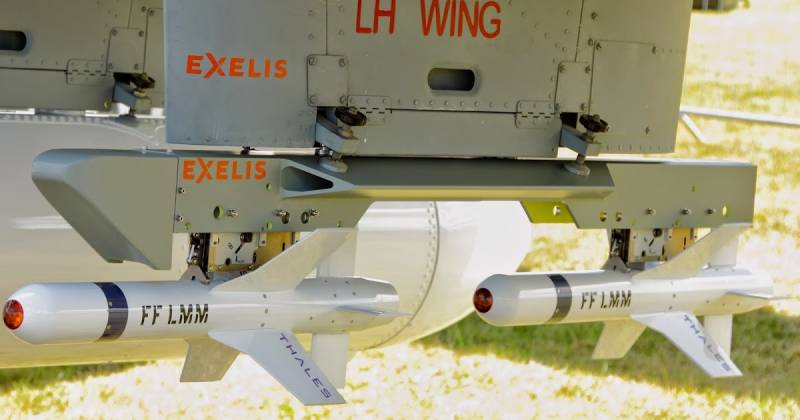
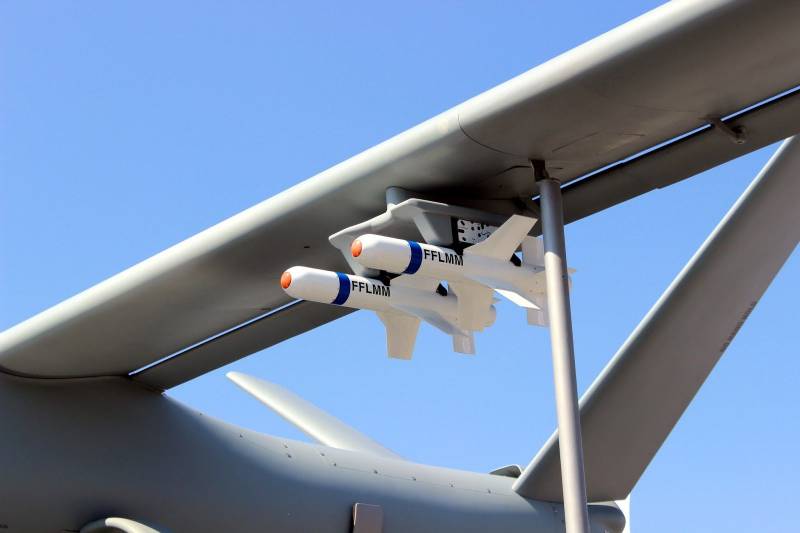
Information